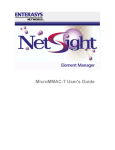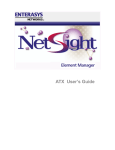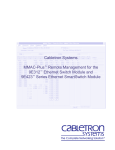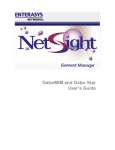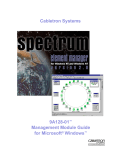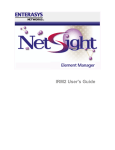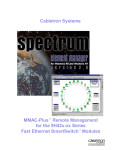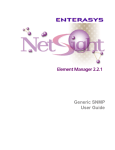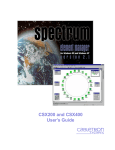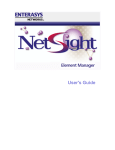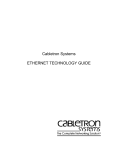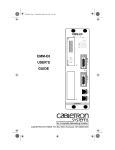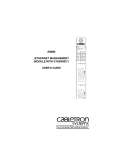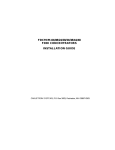Download Enterasys MicroMMAC-T User`s guide
Transcript
FN 100 User’s Guide Notice Enterasys Networks reserves the right to make changes in specifications and other information contained in this document without prior notice. The reader should in all cases consult Enterasys Networks to determine whether any such changes have been made. The hardware, firmware, or software described in this manual is subject to change without notice. IN NO EVENT SHALL ENTERASYS NETWORKS BE LIABLE FOR ANY INCIDENTAL, INDIRECT, SPECIAL, OR CONSEQUENTIAL DAMAGES WHATSOEVER (INCLUDING BUT NOT LIMITED TO LOST PROFITS) ARISING OUT OF OR RELATED TO THIS MANUAL OR THE INFORMATION CONTAINED IN IT, EVEN IF ENTERASYS NETWORKS HAS BEEN ADVISED OF, KNOWN, OR SHOULD HAVE KNOWN, THE POSSIBILITY OF SUCH DAMAGES. Virus Disclaimer Enterasys has tested its software with current virus checking technologies. However, because no antivirus system is 100% reliable, we strongly caution you to write protect and then verify that the Licensed Software, prior to installing it, is virus-free with an anti-virus system in which you have confidence. Enterasys Networks makes no representations or warranties to the effect that the Licensed Software is virus-free. Copyright 2000 by Enterasys Networks. All rights reserved. Printed in the United States of America. Order Number: 9031897-03 April 2000 Enterasys Networks. P.O. Box 5005 Rochester, NH 03866-5005 Enterasys, NetSight, and Matrix E7 are trademarks of Enterasys Networks. Cabletron Systems, SPECTRUM, BRIM, DNI, FNB, INA, Integrated Network Architecture, LANVIEW, LANVIEW Secure, Multi Media Access Center, MiniMMAC, and TRMM are registered trademarks, and Bridge/Router Interface Modules, BRIM-A100, CRBRIM-W/E, CRXMIM, CXRMIM, Desktop Network Interface, Distributed LAN Monitoring, Distributed Network Server, DLM, DNSMIM, E1000, E2000, E3000, EFDMIM, EMM-E6, EMME, EPIM, EPIM-3PS, EPIM-A, EPIM-C, EPIM-F1, EPIM-F2, EPIM-F3, EPIM-T, EPIM-T1, EPIM-X, ESXMIM, ETSMIM, ETWMIM, FDCMIM-04, FDCMIM-08, FDMMIM, FDMMIM-04, Flexible Network Bus, FOMIM, FORMIM, HubSTACK, IRBM, IRM, IRM-2, IRM-3, Media Interface Module, MicroMMAC, MIM, MMAC, MMAC-3, MMAC-3FNB, MMAC-5, MMAC-5FNB, MMAC-8, MMAC-8FNB, MMAC-M8FNB, MMAC-Plus, MRX, MRXI, MRXI-24, MultiChannel, NB20E, NB25E, NB30, NB35, NBR-220/420/620, RMIM, SecureFast Packet Switching, SFPS, SPECTRUM Element Manager, SPECTRUM for Open Systems, SPIM-A, SPIM-C, SPIM-F1, SPIM-F2, SPIM-T, SPIM-T1, TPMIM, TPMIM-22, TPMIM-T1, TPRMIM, TPRMIM-36, TPT-T, TRBMIM, TRMM-2, TRMMIM, and TRXI are trademarks of Cabletron Systems, Inc. i AppleTalk, Apple, Macintosh, and TokenTalk are registered trademarks; and Apple Remote Access and EtherTalk are trademarks of Apple Computer, Inc. SmartBoost is a trademark of American Power Conversion ST is a registered trademark and C++ is a trademark of AT&T Banyan and VINES are registered trademarks of Banyan Systems, Inc. cisco, ciscoSystems, and AGS+ are registered trademarks; and cBus, cisco Router, CRM, IGS, and MGS are trademarks of cisco Systems, Inc. GatorBox is a registered trademark; and GatorMail, GatorMIM, GatorPrint, GatorShare, GatorStar, GatorStar GX-M, and XGator are trademarks of Cayman Systems, Inc. CompuServe is a registered trademark of CompuServe Incorporated X Window System is a trademark of Consortium, Inc. CTERM, DECnet, and ULTRIX are registered trademarks; and DEC, DEC C++, DECnet-DOS, DECstation, VAX DOCUMENT, VMA, and VT are trademarks of Digital Equipment Corporation Fore Systems, ForeRunner, and ForeRunner ASX-100 are trademarks of Fore Systems, Inc. PC/TCP is a registered trademark of FTP Software, Inc. HP OpenView is a registered trademark of Hewlett-Packard, Inc. AIX, IBM, OS/2, NetView, and PS/2 are registered trademarks; and AT, Micro Channel, PC, PC-DOS, PC/XT, Personal Computer AT, Operating System/2, Personal System/2, RISC System/6000, and Workplace Shell are trademarks of International Business Machines Corporation i960 microprocessor is a registered trademark; and Intel and Multichannel are trademarks of Intel Corporation Microsoft, MS-DOS, and Windows are registered trademarks of Microsoft Corporation Chameleon, ChameleonNFS, Chameleon 32, IPX/link, and NEWT are trademarks of NETMANAGE, Inc. NetWare and Novell are registered trademarks; and Internetwork Packet Exchange (IPX), IPX, and Network File System (NFS) are trademarks of Novell, Inc. Motif and MS are registered trademarks; and Open Software Foundation, OSF, OSF/1, and OSF/Motif are trademarks of The Open Software Foundation, Inc. Silicon Graphics and IRIS are registered trademarks; and Indigo and IRIX are trademarks of Silicon Graphics, Inc. NFS, PC-NFS, SPARC, Sun Microsystems, and Sun Workstation are registered trademarks; and OpenWindows, SPARCstation, SPARCstation IPC, SPARCstation IPX, Sun, Sun-2, Sun-3, Sun-4, Sun386i, SunNet, SunOS, SunSPARC, and SunView are trademarks of Sun Microsystems, Inc. OPEN LOOK and UNIX are registered trademarks of Unix System Laboratories, Inc. Ethernet, NS, Xerox Network Systems and XNS are trademarks of Xerox Corporation ii ANNEX, ANNEX-II, ANNEX-IIe, ANNEX-3, ANNEX-802.5, MICRO-ANNEX-XL, and MICROANNEX-ELS are trademarks of Xylogics, Inc. MAXserver and Xyplex are trademarks of Xyplex, Inc. Restricted Rights Notice (Applicable to licenses to the United States Government only.) 1. Use, duplication, or disclosure by the Government is subject to restrictions as set forth in subparagraph (c) (1) (ii) of the Rights in Technical Data and Computer Software clause at DFARS 252.227-7013. Enterasys Networks, 35 Industrial Way, Rochester, New Hampshire 03867. 2. (a) This computer software is submitted with restricted rights. It may not be used, reproduced, or disclosed by the Government except as provided in paragraph (b) of this Notice or as otherwise expressly stated in the contract. (b) This computer software may be: (1) Used or copied for use in or with the computer or computers for which it was acquired, including use at any Government installation to which such computer or computers may be transferred; (2) Used or copied for use in a backup computer if any computer for which it was acquired is inoperative; (3) Reproduced for safekeeping (archives) or backup purposes; (4) Modified, adapted, or combined with other computer software, provided that the modified, combined, or adapted portions of the derivative software incorporating restricted computer software are made subject to the same restricted rights; (5) Disclosed to and reproduced for use by support service contractors in accordance with subparagraphs (b) (1) through (4) of this clause, provided the Government makes such disclosure or reproduction subject to these restricted rights; and (6) Used or copied for use in or transferred to a replacement computer. (c) Notwithstanding the foregoing, if this computer software is published copyrighted computer software, it is licensed to the Government, without disclosure prohibitions, with the minimum rights set forth in paragraph (b) of this clause. (d) Any other rights or limitations regarding the use, duplication, or disclosure of this computer software are to be expressly stated in, or incorporated in, the contract. (e) This Notice shall be marked on any reproduction of this computer software, in whole or in part. iii iv Contents Chapter 1 Introduction Using the FN100 User’s Guide ................................................................................... 1-1 Related Manuals............................................................................................................ 1-2 Software Conventions .................................................................................................. 1-2 Common FN100 Window Fields ......................................................................... 1-3 Using the Mouse .................................................................................................... 1-4 Using Window Buttons......................................................................................... 1-5 Getting Help .................................................................................................................. 1 -6 Using On-line Help................................................................................................ 1-6 Getting Help from the Global Technical Assistance Center ............................ 1-6 Chapter 2 The FN100 Chassis View Viewing Chassis Information ...................................................................................... 2-2 Front Panel Information........................................................................................ 2-2 Menu Structure....................................................................................................... 2-4 The FN100 Port Status Displays .......................................................................... 2-7 Selecting a Port Status View.......................................................................... 2-7 Port Status Color Codes................................................................................. 2-9 The Chassis Manager Window ............................................................................ 2-9 Viewing Hardware Types ................................................................................... 2-10 Viewing the Device Type ............................................................................. 2-10 Viewing the Port Description...................................................................... 2-10 Managing the Hub .......................................................................................................2-11 Using Device Find Source Address....................................................................2-11 Viewing I/F Summary Information.................................................................. 2-13 Interface Performance Statistics/Bar Graphs ........................................... 2-14 Viewing Interface Detail .............................................................................. 2-16 Making Sense of Detail Statistics......................................................... 2-18 Viewing CSMACD Statistics .............................................................................. 2-19 Receive Errors ............................................................................................... 2-19 Transmission Errors...................................................................................... 2-20 Collision Errors ............................................................................................. 2-21 Enabling and Disabling Ports ............................................................................ 2-21 Chapter 3 FN100 Virtual Switching Performing Virtual Switching ..................................................................................... 3-1 Configuring Your Virtual Switch Settings.......................................................... 3-2 Defining a Default Switch ............................................................................. 3-3 v Contents Chapter 4 Using FN100 Trunking The Port Trunking Window ......................................................................................... 4-2 Enabling and Disabling Trunking ....................................................................... 4-5 Chapter 5 Workgroup Configuration Configuring a Workgroup............................................................................................ 5-2 Deleting a Workgroup ........................................................................................... 5-3 Index vi Chapter 1 Introduction How to use this guide; related guides; software conventions; getting help Welcome to the FN100™ User’s Guide. We have designed this guide to serve as a simple reference for using NetSight Element Manager for the FN100. As a part of the Fast Network product line of switches, the FN100 provides a foundation for high speed scalable Ethernet switching solutions. The FN100 is a high performance, intelligent Fast Ethernet switch designed to support full 10 Mbps or 100 Mbps connectivity on 8 or 16 ports over unshielded twisted-pair (UTP) and/or multimode (MM) fiber. The FN100 consists of 8 or 16 10/100BaseTX or 10/100Base FX ports and, in the case of the TX models, 1 or 2 selectable 100Base-FX ports. The FN100 is IEEE 802.2, 802.3 and 802.1d compliant, includes built-in SNMP management, and supports MIB II, PPP, and Enterprise MIB. Using the FN100 User’s Guide Each chapter in this guide describes one major functionality or a collection of several smaller functionalities of the FN100 device module. This guide contains information about software functions which are accessed directly from the device icon. Chapter 1, Introduction, provides a list of related documentation, describes certain software conventions, and shows you how to contact the Global Technical Assistance Center. Chapter 2, The FN100 Chassis View, describes the visual display of the FN100switch and explains how to use the mouse within the Chassis View; the operation of chassis-level management functions — like enabling and disabling ports — is also described here. Chapter 3, FN100 Virtual Switching, describes using the FN100 Virtual Switching window to refine your network and control bandwidth usage by assigning the FN100’s ports to any of four available virtual switches. 1-1 Introduction Chapter 4, Using FN100 Trunking, details using the FN100 Port Trunking window to create trunk groups, allowing you to increase aggregate bandwidth when two or more switches are connected. Chapter 5, Workgroup Configuration, describes configuring work groups by specifying a subset of device ports and the type(s) of packets (multicast, unicast, or both) that are to be forwarded by those ports, thereby allowing you to restrict multicast traffic from being propagated through every bridge port on your device. Related Manuals The FN100 User’s Guide is only part of a complete document set designed to provide comprehensive information about the features available to you through NetSight Element Manager. Other guides which include important information related to managing the FN100 include: User’s Guide Tools Guide Remote Administration Tools User’s Guide Remote Monitoring (RMON) User’s Guide Alarm and Event Handling User’s Guide For more information about the capabilities of the FN100, consult the appropriate hardware documentation. Software Conventions NetSight Element Manager’s device user interface contains a number of elements which are common to most windows and which operate the same regardless of which window they appear in. A brief description of some of the most common elements appears below; note that the information provided here is not repeated in the descriptions of specific windows and/or functions. 1-2 Related Manuals Introduction Common FN100 Window Fields Similar descriptive information is displayed in boxes at the top of most devicespecific windows in NetSight Element Manager, as illustrated in Figure 1-1. Device Name IP Address Location MAC Address Figure 1-1. Sample Window Showing Informational Text Boxes Device Name Displays the user-defined name of the device. The device name can be changed via the System Group window; see the Generic SNMP User’s Guide for details. IP Address Displays the device’s IP (Internet Protocol) Address; this will be the IP address used to define the device icon. IP addresses are assigned via Local Management for the FN100; they cannot be changed via NetSight Element Manager. Location Displays the user-defined location of the device. The location is entered through the System Group window; see the Generic SNMP User’s Guide for details. Software Conventions 1-3 Introduction MAC Address Displays the manufacturer-set MAC address associated with the IP Address used to define the device icon when it was added to NetSight Element Manager. This address is factory-set and cannot be altered. Informational fields describing the boards and/or ports being modeled are also displayed in most windows: Port Number Displays the number of the monitored port. Uptime Displays the amount of time, in a X days hh:mm:ss format, that the FN100 has been running since the last start-up. Using the Mouse This document assumes you are using a Windows-compatible mouse with two buttons; if you are using a three button mouse, you should ignore the operation of the middle button when following procedures in this document. Procedures within the NetSight Element Manager document set refer to these buttons as follows: Left Mouse Button Right Mouse Button Figure 1-2. Mouse Buttons For many mouse operations, this document assumes that the left (primary) mouse button is to be used, and references to activating a menu or button will not include instructions about which mouse button to use. However, in instances in which right (secondary) mouse button functionality is available, instructions will explicitly refer to right mouse button usage. Also, in situations where you may be switching between mouse buttons in the same area or window, instructions may also explicitly refer to both left and right mouse buttons. 1-4 Software Conventions Introduction Instructions to perform a mouse operation include the following terms: • Pointing means to position the mouse cursor over an area without pressing either mouse button. • Clicking means to position the mouse pointer over the indicated target, then press and release the appropriate mouse button. This is most commonly used to select or activate objects, such as menus or buttons. • Double-clicking means to position the mouse pointer over the indicated target, then press and release the mouse button two times in rapid succession. This is commonly used to activate an object’s default operation, such as opening a window from an icon. Note that there is a distinction made between “click twice” and “double-click,” since “click twice” implies a slower motion. • Pressing means to position the mouse pointer over the indicated target, then press and hold the mouse button until the described action is completed. It is often a pre-cursor to Drag operations. • Dragging means to move the mouse pointer across the screen while holding the mouse button down. It is often used for drag-and-drop operations to copy information from one window of the screen into another, and to highlight editable text. Using Window Buttons The Cancel button that appears at the bottom of most windows allows you to exit a window and terminate any unsaved changes you have made. You may also have to use this button to close a window after you have made any necessary changes and set them by clicking on an OK, Set, or Apply button. An OK, Set, or Apply button appears in windows that have configurable values; it allows you to confirm and SET changes you have made to those values. In some windows, you may have to use this button to confirm each individual set; in other windows, you can set several values at once and confirm the sets with one click on the button. The Help button brings up a Help text box with information specific to the current window. For more information concerning Help buttons, see Getting Help, page 1-6. The command buttons, for example Bridge, call up a menu listing the windows, screens, or commands available for that topic. Any menu topic followed by ... (three dots) — for example Statistics... — calls up a window or screen associated with that topic. Software Conventions 1-5 Introduction Getting Help This section describes two different methods of getting help for questions or concerns you may have while using NetSight Element Manager Using On-line Help You can use the FN100 window Help buttons to obtain information specific to the device. When you click on a Help button, a window will appear which contains context-sensitive on-screen documentation that will assist you in the use of the windows and their associated command and menu options. If a Help button is grayed out, on-line help has not yet been implemented for the associated window. From the Help menu accessed from the Chassis View window menu bar, you can access on-line help specific to the Chassis View window, as well as bring up the Chassis Manager window for reference. Refer to Chapter 2 for information on the Chassis View and Chassis Manager windows. NOTE All of the on-line help windows use the standard Microsoft Windows help facility. If you are unfamiliar with this feature of Windows, you can select Help from the Start menu, or Help —>How to Use Help from the primary NetSight Element Manager window. Getting Help from the Global Technical Assistance Center If you need technical support related to NetSight Element Manager, contact the Global Technical Assistance Center via one of the following methods: By phone: (603) 332-9400 24 hours a day, 365 days a year By fax: (603) 337-3075 By mail: Enterasys Networks PO Box 5005 Rochester, NH 03866-5005 By e-mail: [email protected] FTP: ftp.ctron.com (134.141.197.25) Login Password By BBS: Modem Setting 1-6 anonymous your e-mail address (603) 335-3358 8N1: 8 data bits, 1 stop bit, No parity Getting Help Introduction Send your questions, comments, and suggestions regarding NetSight Element Manager to NetSight Technical Communications via the following address: [email protected] To locate product specific information, refer to the Enterasys Web site: http://www.enterasys.com/ NOTE Getting Help For the highest firmware versions successfully tested with NetSight Element Manager 2.2.1, refer to the Readme file available from the NetSight Element Manager 2.2.1 program group. If you have an earlier version of firmware and experience problems, contact Technical Support for upgrade information. 1-7 Introduction 1-8 Getting Help Chapter 2 The FN100 Chassis View About the Chassis View window; the Chassis Manager window; Hub management functions The FN100 Chassis View window is the main screen that immediately informs you of the current condition of individual ports on your switch via a graphical display. The Chassis View window also serves as a single point of access to all other FN100 windows and screens, which are discussed at length in the following chapters. To access the FN100 Chassis View window, use one of the following options: 1. In any map, list, or tree view, double-click on the FN100 you wish to manage; or 1. In any map, list, or tree view, click the left mouse button once to select the FN100 device you wish to manage. 2. Select Manage—>Node from the main NetSight Element Manager window menu bar, or select the Manage Node toolbar button. or 1. In any map, list, or tree view, click the right mouse button once to select the FN100 device you wish to manage. 2. On the resulting menu, click to select Manage. 2-1 The FN100 Chassis View Viewing Chassis Information The FN100 Chassis View window (Figure 2-1) provides a graphic representation of the FN100, including a color-coded port display which immediately informs you of the current configuration and status of the switch and its ports. On an 8-port FN100, the network management port is represented as port 9. On a 16-port FN100, the network management port will be represented as port 17. Figure 2-1. FN100 Chassis View Window By clicking in designated areas of the chassis graphical display (as detailed later in this chapter), or by using the menu bar at the top of the Chassis View window, you can access all of the menus that lead to more detailed device- and port- level windows. TIP When you move the mouse cursor over a management “hot spot” the cursor icon will change into a “hand” to indicate that clicking in the current location will bring up a management option. Front Panel Information The areas above and below the main port display area provide the following device information: IP The Internet Protocol address assigned to the FN100 appears in the title bar of the Chassis View window; this field will display the IP address you have used to create the FN100 icon. IP addresses are assigned via Local Management. Connection Status This color-coded area indicates the current state of communication between NetSight Element Manager and the FN100. 2-2 Viewing Chassis Information The FN100 Chassis View • Green indicates the FN100 is responding to device polls (valid connection). • Magenta indicates that the FN100 is in a temporary stand-by mode while it responds to a physical change in the hub; note that port menus are inactive during this stand-by state. • Blue indicates an unknown contact status – polling has not yet been established with the FN100. • Red indicates the FN100 is not responding to device polls (device is off line, or device polling has failed across the network for some other reason). UpTime The amount of time, in a day(s) hh:mm:ss format, that the FN100 has been running since the last start-up. Port Status If management for your device supports a variable port display (detailed in The FN100 Port Status Displays, later in this chapter), this field will show the display currently in effect. If only a single port display is available — or if the default view is in effect — this field will state Default. MAC The physical layer address assigned to the interface associated with the IP Address used to define the device icon when it was added to NetSight Element Manager. MAC addresses are factory-set cannot be altered. NOTE Boot Prom, Firmware, Time, and Date, are not available for the FN100 at the time of this release. Boot Prom The revision of BOOT PROM installed in the FN100. Firmware The revision of device firmware stored in the FN100’s FLASH PROMs. Time The current time, in a 24-hour hh:mm:ss format, set in the FN100’s internal clock. Date The current date, in an mm/dd/yy format, set in the FN100’s internal clock. Viewing Chassis Information 2-3 The FN100 Chassis View Menu Structure By clicking on various areas of the FN100 Chassis View display, you can access menus with device- and port-level options, as well as utility applications which apply to the device. The following illustration displays the menu structure and indicates how to use the mouse to access the various menus: Figure 2-2. FN100 Chassis View Menu Structure The Device Menu From the Device Menu at the Chassis View window menu bar, you can access the following selections: 2-4 • Device Type..., which displays a window containing a description of the device being modeled. See Viewing the Device Type for details. • Device Find Source Address, enables you to determine through which interface a specified MAC address is communicating by searching the 802.1d bridge Filtering database. Ethernet MicroLAN switches will also search the repeater Source Address Table (SAT). If the specified MAC address is located, a list of interface(s) through which the given address is communicating will be displayed. • System Group..., which allows you to manage the FN100 via SNMP MIB II. Refer to the Generic SNMP User’s Guide for further information. • I/F Summary, which allows you to view statistics (displayed both graphically and numerically) for the traffic processed by each network interface on your FN-10. See Viewing I/F Summary Information on page 2-13 for more information. Viewing Chassis Information The FN100 Chassis View • Virtual Switching..., which launches the FN100 Virtual Switching window, allowing you to refine your network and control bandwidth usage by assigning the FN100’s ports to any of four available virtual switches. See Chapter 3, FN100 Virtual Switching, for details. • Port Trunking..., which allows you to use the FN100 Port Trunking window to create trunk groups, letting you increase aggregate bandwidth when two or more switches are connected. See Chapter 4, Using FN100 Trunking, for details. • Workgroups..., which invokes a window that lets you configure work groups by specifying a subset of device ports and the type(s) of packets (multicast, unicast, or both) that are to be forwarded by those ports, thereby allowing you to restrict multicast traffic from being propagated through every bridge port on your device. See Chapter 5, Workgroup Configuration, for details. • Bridge Status..., which opens a window that provides an overview of bridging information for each interface, and allows you to access all other bridgerelated options. Refer to the bridging chapter in the Tools Guide for details. • Exit, which closes the FN100 Chassis View window. The Port Status Menu The Port Status Menu allows you to select the status information that will be displayed in the port text boxes in the Chassis View window: • Status allows you to select one of three status type displays: Bridge, Admin, or Operator. • Load will display the portion of network load processed per polling interval by each interface as a percentage of the theoretical maximum load (10 or 100 Mbits/sec). • Errors allows you to display the number of errors detected per polling interval by each interface as a percentage of the total number of valid packets processed by the interface. • I/F Mapping will display the interface (if) index associated with each port on your FN100 switch. • I/F Speed will display the speed (100 Mbits/sec) of the network segment attached to each port. The speed of the network management port will be displayed in Kbits/sec. • I/F Type will display the interface type of each port in the FN100 — i.e., Eth (ethernet-csmacd) for the bridging interfaces, and PPP for the network management port. • Bridge Type refers to the type of bridging in effect, which will always be TP (transparent) on an FN100. For more information on the port display options available via this menu, see The FN100 Port Status Displays, later in this chapter. Viewing Chassis Information 2-5 The FN100 Chassis View The Utilities Menu From the Utilities menu you can select: NOTE • MIB Tools, provides direct access to the FN100’s MIB information. This selection is also available from the Tools menu at the top of the NetSight Element Manager’s main window. Refer to the Tools Guide for more information on the MIB Tools utility. • RMON, for launching the Remote Network Monitoring application. RMON is described in its own User’s Guide. Like MIB Tools, RMON can also be launched from the Tools menu. Using the MIBTools utility, you will have access to MIB information for FN100 interfaces that are assigned to the default virtual switch. MIB information for interfaces assigned to a virtual switch other than the default virtual switch will be unavailable via MIBTools. See Chapter 3, FN100 Virtual Switching, for details on viewing and changing the default virtual switch setting. The Help Menu The Help Menu has two selections: • Mibs Supported, which brings up the Chassis Manager window. See The Chassis Manager Window, later in this chapter, for details. • Chassis Manager Help, which brings up a help window with information specifically related to using the Chassis Manager and Chassis View windows. • About Chassis Manager..., which brings up a version window for the Chassis Manager application in use. The Port Menus The menu for bridging ports offers the following selections: 2-6 • Description..., which brings up a window describing the selected port; see Viewing the Port Description, later in this chapter. • Performance Graph..., which allows you to view the traffic going through a selected bridge. This information is displayed both numerically and graphically, as described in your Tools Guide bridging chapter. • Source Addressing..., which displays a list of MAC Addresses that communicate through the selected bridge port. • I/F Statistics..., which allows you to view color-coded statistical information about the selected bridge port; see Viewing Interface Detail later in this chapter. • CSMACD Stats..., which graphically displays Receive, Transmission, and Collision errors over the selected bridge port; see Viewing CSMACD Statistics later in this chapter. Viewing Chassis Information The FN100 Chassis View • Enable/Disable, which administratively turns the selected bridging port on or off; see Viewing I/F Summary Information on page 2-13 for more information. The FN100 Port Status Displays When you open the Chassis View window, each port on the FN100 will display its Admin status (defined below); to change this status display, select one of the options on the Port Status menu, as described in the following sections. Selecting a Port Status View To change the status of your ports: 1. Click on Port Status on the menu bar at the top of the Chassis View window; a menu will appear. 2. Drag down (and to the right, if necessary) to select the status information you want to display. The port text boxes will display the appropriate status information. Port status view options are: Status You can view four status categories for your ports: • • • • Bridge — FWD (forwarding), DIS (disabled), LIS (listening), LRN (learning), BLK (blocking), BRK (broken), or UNK (unknown). Bridge Mapping — bridge interface index numbers Admin — ON or OFF Operator — ON or OFF If you have selected the Bridge status mode, a port is considered: • FWD (forwarding) when the interface is on-line and forwarding packets from one network segment to another. • DIS (disabled) when bridging at the interface has been disabled by management, and no traffic can be received or forwarded on this interface. • LIS (listening) when the interface is not adding information to the filtering database. It is monitoring Bridge Protocol Data Unit (BPDU) traffic while preparing to move to the forwarding state. • LRN (learning) when the Forwarding database is being created, or the Spanning Tree Algorithm is being executed because of a network topology change. • BLK (blocking) when the interface is on-line, but filtering traffic from going across the FN100 from one network segment to another. Viewing Chassis Information 2-7 The FN100 Chassis View • BRK (broken) when the physical interface has malfunctioned. • UNK (unknown) if the interface’s status cannot be determined. If you have selected Bridge Mapping, the port status boxes will display the bridge interface index numbers assigned to each interface (which may or may not match the ifIndex values displayed via the I/F Mapping option described below). If you have selected the Admin status mode, a port is considered: • ON if the port has been enabled by management. • OFF if the port has been disabled by management. If you have selected the Operator status mode, a port is considered: • ON if the port is actively forwarding and receiving packets. • OFF if the port is not currently forwarding and receiving packets. Load If you choose Load, the interface text boxes will display the percentage of network load processed by each port during the last polling interval. This percentage reflects the network load generated per polling interval by devices connected to the port compared to the theoretical maximum load (10 or 100 Mbits/sec) of an Ethernet network. Errors If you choose the Errors mode, the interface boxes will display the percentage of the total number of valid packets processed by each port during the last polling interval that were error packets. This percentage reflects the number of errors generated during the last polling interval by devices connected to that port compared to the total number of valid packets processed by the port. NOTE The polling interval is set via the Tools —> Options...—>Polling option from the main window’s menu bar. Refer to the User’s Guide for full information on setting device polling intervals. I/F Mapping If you choose the I/F Mapping mode, each port text box will display its MIB II ifIndex value. I/F Speed If you choose the I/F Speed mode, the port text boxes will display the speed (100 Mbits/sec) of the network segment connected to each port. The speed of the network management port will be displayed in Kbits/sec. 2-8 Viewing Chassis Information The FN100 Chassis View I/F Type If you choose the I/F Type mode, the port text boxes will display the port type (e.g., Eth, PPP) of each port, as determined by the port’s MIB II ifType value. Port Status Color Codes The Bridge port display mode incorporates the following color-coding scheme: green = FWD, blue = DIS, magenta = LIS/LRN, orange = BLK, red = BRK, and gray = UNK. The Admin and Operator port display modes use the following color-coding scheme: green = ON, red = OFF. For the Load, Errors, I/F Mapping, I/F Speed, and I/F Type port display modes, color codes will continue to reflect the most recently selected mode which incorporates its own color coding scheme. The Chassis Manager Window The FN100 draws its functionality from a collection of proprietary MIBs and IETF RFCs, and organizes its MIB data into a series of components. A MIB component is a logical grouping of MIB data; each group controls a defined set of objects. For example, FN100 bridging information is organized into its own component. Note, too, that there is no one-to-one correspondence between MIBs and MIB components; a single MIB component might contain objects from several different proprietary MIBs and RFCs. The Chassis Manager window, Figure 2-3, is a read-only window that displays the MIBs and the MIB components — and, therefore, the functionality — supported by the currently monitored device. To view the Chassis Manager window: 1. Click on Help on the menu bar at the top of the Chassis View window. 2. Drag down to MIBs Supported, and release. Viewing Chassis Information 2-9 The FN100 Chassis View The MIBs which provide the FN100’s functionality — both proprietary MIBs and IETF RFCs — are listed here. MIB Components are listed here; remember, there’s no one-to-one correspondence between MIBs and MIB Components. Figure 2-3. Chassis Manager Window Viewing Hardware Types In addition to the graphical displays described above, menu options available at several levels provide specific information about the physical characteristics of the FN100 and its ports. Viewing the Device Type Choosing the Device Type... option on the Device menu brings up a window that describes the management device being modeled: Figure 2-4. Device Type Window Viewing the Port Description Choosing the Description... option on the individual port interface menus brings up a window that describes that interface you have selected. Depending on the type of port you select, one of the following windows will appear: 2-10 Viewing Chassis Information The FN100 Chassis View Figure 2-5. Port Description Windows Managing the Hub In addition to the performance and configuration information described in the preceding sections, the Chassis View also provides you with the tools available to configure your device and keep it operating properly. Hub management for the FN100 is comprised of locating source addresses, viewing interface statistics and CSMACD statistics, as well as administratively enabling and disabling the ports. Using Device Find Source Address When you select the Device Find Source Address option, the device’s 802.1d Filtering database is searched for the specified MAC address. If it is found, the Component field will display the value “Bridge” indicating that the address was found on a bridging interface, and the Port Instance field will display the index number assigned to the bridge port on which the address was located. NOTE You may receive an error message stating “Can’t Display Source Address” if a Port Instance of “0” or “0.0” is reported. This value indicates that the MAC address is communicating through the backplane instead of through a front panel interface. To open the Device Find Source Address window: 1. Click on Device in the Chassis View menu bar. 2. Click on Device Find Source Address. The Device Find Source Address window, as shown in Figure 2-6, opens. Managing the Hub 2-11 The FN100 Chassis View Figure 2-6. Device Find Source Address Window The Device Find Source Address window displays the following information: Component Displays the type of interface through which the specified MAC address is communicating. This field will report Bridge. Port Instance Displays the bridge port index number on which the specified MAC address was found. To use the Device Find Source Address window: 1. In the Address Mode field, select the format of the Source Address you wish to find, either MAC or Canonical. 2. In the Enter Address text box, enter the Source Address you wish to find in the appropriate XX-XX-XX-XX-XX-XX format. NOTE If you enter the MAC format of a specified address, and then click on Canonical, NetSight Element Manager will do the address conversion for you, from the Ethernet hexadecimal format to the Token Ring Canonical format. The same is also true if you enter the Canonical format of a specified address and then select MAC. 3. Click on the Find It! button. A “Processing Request” message opens in the status bar at the bottom of the window. 2-12 Managing the Hub The FN100 Chassis View If the specified MAC address is located, a list of the interface(s) through which the given address is communicating displays in the list box. A status message at the bottom of the window will display the number of interfaces through which the given MAC address is communicating. If the specified MAC address cannot be found, a “Source Address not found” message displays. NOTE If the MAC address is entered in an incorrect format, an “Invalid MAC Address. Enter Valid MAC Address” message displays. Enter the address in the correct XX-XX-XX-XX-XX-XX hexadecimal format. Viewing I/F Summary Information The I/F Summary menu option available from the Device menu lets you view statistics for the traffic processed by each network interface on your device. The window also provides access to a detailed statistics window that breaks down Transmit and Receive traffic for each interface. To access the I/F Summary window: 1. From the Module View, click on the Device option from the menu bar. 2. Click again to select I/F Summary, and release. The I/F Summary window, Figure 2-7, will appear. Figure 2-7. I/F Summary Window The I/F Summary window provides a variety of descriptive information about each interface on your device, as well as statistics which display each interface’s performance. Managing the Hub 2-13 The FN100 Chassis View The following descriptive information is provided for each interface: UpTime The UpTime field lists the amount of time, in a days, hh:mm:ss format, that the device has been running since the last start-up. Index The index value assigned to each interface on the device. Type The type of the interface, distinguished by the physical/link protocol(s) running immediately below the network layer. Possible values are ethernet-csmacd (for both standard and Fast Ethernet front panel interfaces) and PPP. Description A text description of the interface: Ethernet, Fast Ethernet, or Network Management Port. Physical Status Displays the current physical status — or operational state — of the interface: Online or Offline. Logical Status Displays the current logical status — or administrative state — of the interface: Up or Down. Interface Performance Statistics/Bar Graphs The statistical values (and, where available, the accompanying bar graphs) to the right of the interface description fields provide a quick summary of interface performance. You can select the statistical value you want to display and the units in which you want those values displayed by using the two menu fields directly above the interface display area, as follows: 1. In the right-most menu field, click on the down arrow and select the unit in which you wish to display the selected statistic: Load, Raw Counts, or Rate. NOTE Bar graphs are only available when Load is the selected base unit; if you select Raw Counts or Rate, the Bar Graph column will be removed from the interface display. 2. Once you have selected the base unit, click on the down arrow in the left-most field to specify the statistic you’d like to display. Note that the options available from this menu will vary depending on the base unit you have selected. 2-14 Managing the Hub The FN100 Chassis View After you select a new display mode, the statistics (and graphs, where applicable) will refresh to reflect the current choice, as described below. Raw Counts The total count of network traffic received or transmitted on the indicated interface since device counters were last reset. Raw counts are provided for the following parameters: In Octets Octets received on the interface, including framing characters. In Packets Packets (both unicast and non-unicast) received by the device interface and delivered to a higher-layer protocol. In Discards Packets received by the device interface that were discarded even though no errors prevented them from being delivered to a higher layer protocol (e.g., to free up buffer space in the device). In Errors Packets received by the device interface that contained errors that prevented them from being delivered to a higher-layer protocol. In Unknown Packets received by the device interface that were discarded because of an unknown or unsupported protocol. Out Octets Octets transmitted by the interface, including framing characters. Out Packets Packets transmitted, at the request of a higher level protocol, by the device interface to a subnetwork address (both unicast and non-unicast). Out Discards Outbound packets that were discarded by the device interface even though no errors were detected that would prevent them from being transmitted. A possible reason for discard would be to free up buffer space in the device. Out Errors Outbound packets that could not be transmitted by the device interface because they contained errors. Load The number of bytes processed by the indicated interface during the last poll interval in comparison to the theoretical maximum load of the network to which the device is connected (100 Mbps for Fast Ethernet). Load is further defined by the following parameters: In Octets Managing the Hub The number of bytes received by this interface, expressed as a percentage of the theoretical maximum load. 2-15 The FN100 Chassis View Out Octets The number of bytes transmitted by this interface, expressed as a percentage of the theoretical maximum load. When you select this option, a Bar Graph field will be added to the interface display area; this field is only available when Load is the selected base unit. Rate The count for the selected statistic during the last poll interval. The available parameters are the same as those provided for Raw Counts. Refer to the Raw Counts section, above, for a complete description of each parameter. Viewing Interface Detail The Interface Statistics window (Figure 2-8) provides detailed MIB-II interface statistical information — including counts for both transmit and receive packets, and error and buffering information — for each individual port interface. Colorcoded pie charts also let you graphically view statistics for both received and transmitted Unicast, Multicast, Discarded, and Error packets. To open the Interface Statistics window: 1. In the I/F Summary window, click to select the interface for which you’d like to view more detailed statistics. 2. Click on Detail. The appropriate I/F Statistics window will appear. Figure 2-8. Detail Interface Statistics 2-16 Managing the Hub The FN100 Chassis View TIP You can also access this information via the I/F Statistics option available on the individual port menus. Three informational fields appear in the upper portion of the window: Description Displays the interface description for the currently selected interface: Ethernet or Fast Ethernet. Address Displays the MAC (physical) address of the selected interface. Type Displays the interface type of the selected port: ethernet-csmacd. The lower portion of the window provides the following transmit and receive statistics; note that the first four statistics are also graphically displayed in the pie charts. Unicast Displays the number of packets transmitted to or received from this interface that had a single, unique destination address. These statistics are displayed in the pie chart, color-coded green. Non-Unicast Displays the number of packets transmitted to or received from this interface that had a destination address that is recognized by more than one device on the network segment. The multicast field includes a count of broadcast packets — those that are recognized by all devices on a segment. These statistics are displayed in the pie chart, color-coded dark blue. Discarded Displays the number of packets which were discarded even though they contained no errors that would prevent transmission. Good packets are typically discarded to free up buffer space when the network becomes very busy; if this is occurring routinely, it usually means that network traffic is overwhelming the device. To solve this problem, you may need to re-configure your bridging parameters, or perhaps re-configure your network to add additional bridges or switches. These statistics are displayed in the pie chart, color-coded magenta. Error Displays the number of packets received or transmitted that contained errors. These statistics are displayed in the pie chart, color-coded red. Managing the Hub 2-17 The FN100 Chassis View Unknown Protocol (Received only) Displays the number of packets received which were discarded because they were created under an unknown or unsupported protocol. Packets Received (Received only) Displays the number of packets received by the selected interface. Transmit Queue Size (Transmit only) Displays the number of packets currently queued for transmission from this interface. The amount of device memory devoted to buffer space, and the traffic level on the target network, determine how large the output packet queue can grow before the FN100 will begin to discard packets. Packets Transmitted (Transmit only) Displays the number of packets transmitted by this interface. Making Sense of Detail Statistics The statistics available in this window can give you an idea of how an interface is performing; by using the statistics in a few simple calculations, it’s also possible to get a sense of an interface’s activity level: To calculate the percentage of input errors: Received Errors /Packets Received To calculate the percentage of output errors: Transmitted Errors /Packets Transmitted To calculate the total number of inbound and outbound discards: Received Discards + Transmitted Discards To calculate the percentage of inbound packets that were discarded: Received Discards /Packets Received To calculate the percentage of outbound packets that were discarded: Transmit Discards /Packets Transmitted NOTE 2-18 The Interface Statistics window does not offer Disable or Test options. These options are available in the Interface Group window, which can be accessed via the System Group window (select System Group... from the Device menu). Refer to your Generic SNMP User’s Guide for information on the System Group and Interface Group windows. Managing the Hub The FN100 Chassis View Viewing CSMACD Statistics The CSCMACD Statistics Windows display statistics for each bridging interface on your FN100. Receive errors, transmission errors, and collision errors are displayed in this window. Three color-coded pie charts allow you to view the breakdowns of each statistics group. To access the CSMACD Statistics window from the Chassis View window: 1. Click on the desired port to reveal the Port menu. 2. Choose CSMACD Stats.... The following window will appear (Figure 2-9). NOTE The CSMACD Statistics window can also be accessed from the Bridge Status window. See the bridging chapter in the Tools Guide for more information. Figure 2-9. CSMACD Statistics Window Each of the receive, transmission, and collision errors is described below. Receive Errors Alignment The number of frames received on a particular interface that contain a nonintegral number of bytes (color-coded green). Misaligned packets can result from Managing the Hub 2-19 The FN100 Chassis View a MAC layer packet formation problem, or from a cabling problem that is corrupting or losing data. FCS The number of frames received on a particular interface that are an integral number of bytes in length, but do not pass the FCS (Frame Check Sequence) check. FCS, or Frame Check Sequence, errors occur when packets are somehow damaged on transit. When each packet is transmitted, the transmitting interface computes a frame check sequence (FCS) value based on the contents of the packet, and appends that value to the packet. The receiving interface performs the same computation; if the FCS values differ, the packet is assumed to have been corrupted and is counted as an FCS error. SQE Test Displays the number of times that the SQE Test Error message is generated by the PLS sublayer on the selected interface. The SQE (Signal Quality Error) Test tests the collision detect circuitry after each transmission. If the SQE Test fails, a SQE Test Error is sent to the interface to indicate that the collision detect circuitry is malfunctioning. Carrier Sense Displays the number of times that the carrier sense condition was lost or never asserted when attempting to transmit a frame on a particular interface. Carrier sense describes the action an interface desiring to transmit will take to listen to the communication channel to see if any other interface is transmitting. If a “carrier is sensed,” the sensing interface will wait a random length of time, and then attempt to transmit. Frame Too Long Displays the amount of frames received on this interface that exceed the maximum permitted frame size. Internal MAC The number of frames that failed to be received by the interface due to an internal MAC sublayer receive error. These errors are only counted if a Frame Too Long, Alignment, or FCS Error did not occur along with the internal MAC error. Receive Errors Displays the total number of receive errors of all types that were detected by the selected interface while it was receiving a transmission. Transmission Errors Deferred Displays the number of frames for which the first transmission attempt on this interface is delayed because the medium is busy. 2-20 Managing the Hub The FN100 Chassis View Internal MAC The number of frames for which transmission fails due to an internal MAC sublayer transmit error. This error is only counted in this window if there have not been corresponding Late Collisions, Excessive Collisions, or Carrier Sense Errors. Transmit Errors The total of transmission errors of all types that occurred while the selected interface was attempting to transmit frames. Collision Errors Single Displays the number of successfully transmitted frames on the selected interface for which transmission was prevented by one collision. Multiple Displays the number of successfully transmitted frames on the selected interface for which transmission was prevented by more than one collision. Late Displays the number of times that a collision has been detected on this interface later than 51.2 microseconds into the transmission of the packet on a 10 Mbit/s system or later than 5.12 microseconds on a 100 Mbit/s system. Excessive Displays the number of frames from this interface for which transmission was not complete due to excessive collisions. Collision Errors Displays the total number of collision errors of all types that occurred during transmission from this interface. Enabling and Disabling Ports From the Port menus on the FN100 Chassis View window, you can administratively enable and disable the ports. When you administratively disable a bridge port, you disconnect that port’s network from the bridge entirely. The port does not forward any packets, nor does it participate in Spanning Tree operations. Nodes connected to the network can still communicate with each other, but they can’t communicate with the bridge or with other networks connected to the bridge. When you enable a port, the port moves from the Disabled state, through the Learning and Listening states, to the Forwarding state; bridge port state color codes will change accordingly. Managing the Hub 2-21 The FN100 Chassis View To enable or disable a bridge port: 1. Click on the desired Port index. The Port menu will appear. 2. Click on Enable to enable the port, or Disable to disable the port. You will get a confirmation window asking if you’re “sure you want to Enable/Disable this Bridge Port.” Click OK and your port will now be enabled or disabled. NOTE 2-22 For more information about bridging functions and how to determine the current state of each bridge port, see the bridging chapter in the Tools Guide. Managing the Hub Chapter 3 FN100 Virtual Switching FN100 virtual switches; performing virtual switching The FN100 Virtual Switching window (Figure 3-1) allows you to refine your network and control bandwidth usage by assigning the FN100’s ports to any of four available virtual switches. This feature can be used to logically group network users and control the amount and type of traffic that is propagated beyond each logical group. Using this window, you can configure up to four logical segments that can include multiple physical segments attached to the front panel ports (e.g., physical segments inserted in ports 1, 2, 5, and 8 could all be assigned to Switch 3, and would communicate as if they actually were on the same physical segment). Using this capability, 10 and 100 Mbps devices can be placed on separate physical segments, allowing the 100 Mbps devices to operate at full speed, and the switch can treat both segments as a single logical network. Each virtual switch is assigned a unique bridge ID and is treated as a separate bridge by Spanning Tree. The bridge ID for each virtual switch is based on the MAC address of the port in each group with the lowest index number. The Default Switch setting determines which of the four available virtual switches is queried for port-specific information for the Spanning Tree protocol. Because each virtual switch is treated as a separate bridge by Spanning Tree, only ports which are assigned to the Default Switch will be recognized by Spanning Tree and correctly represented in the Bridge Status window. Performing Virtual Switching To launch the FN100 Virtual Switching window from the FN100 Chassis View: 1. Click to display the Device menu. 2. Drag down to Virtual Switching..., and release. The Virtual Switching window (Figure 3-1) will appear. 3-1 FN100 Virtual Switching Figure 3-1. The Virtual Switching Window The Virtual Switching window features a column of four radio buttons (one button for each virtual switch) for each of the FN100’s ports. The port indices are listed atop each column. The Virtual Switching window also features: Update When the Update button is clicked, the FN100 will be queried for its virtual switch settings, and any changes that have occurred since the window was opened (or since the Update button was last clicked) will be reflected in the window. Configuring Your Virtual Switch Settings To assign the FN100’s ports to any of the four virtual switches: 1. For each port that you wish to assign to a virtual switch, click on the port’s radio button (in the column beneath the port’s index number) that corresponds to the desired switch setting. 2. Click Apply. The Virtual Switching window will update to reflect the new configuration. NOTE 3-2 If you use the Virtual Switching window to assign ports to a virtual switch other than the one defined as the default switch, those ports will not be correctly represented in the Bridge Status window. This is because each virtual switch has a separate bridge ID and is treated as a separate bridge by Spanning Tree. To correctly view these ports in the Bridge Status window, you must change the default virtual switch setting using the Default Switch field. Performing Virtual Switching FN100 Virtual Switching Defining a Default Switch By defining a default switch setting, you decide which of the FN100’s four virtual switches will be recognized by Spanning Tree and reflected in the FN100 Bridge Status window. When you change the default switch, only those ports which are assigned to the selected default switch will be correctly displayed in the Bridge Status window. All other ports will return an UNKNOWN bridge state. To define a default switch for your FN100: 1. Click the I-bar cursor ( ) next to the Default Switch: field near the bottom of the Virtual Switching window. The Change Default Switch window will appear. Figure 3-2. The Change Default Switch Window 2. Enter the desired default switch number. Allowable entries are 1, 2, 3, or 4. 3. Click OK to select the default switch you have entered. Click Cancel to exit the window without making any changes. NOTE When the FN100 is reset, all ports will revert to Virtual Switch #1. The Default Switch will also revert to 1. Performing Virtual Switching 3-3 FN100 Virtual Switching 3-4 Performing Virtual Switching Chapter 4 Using FN100 Trunking The Trunking Table window; enabling and disabling trunking Trunking, an extension of the 802.1D Spanning Tree protocol, allows you to increase aggregate bandwidth when two or more switches are connected. A single 10/100BASE-T connection between switches yields 10 or 100 Mbps of bandwidth, depending on the speed of the ports used for the connection. A trunk group is created when two or more ports on the same switch (for which trunking protocol is enabled) are physically connected to the same remote switch. By creating a trunk group, each additional connection results in another 10 or 100 Mbps of bandwidth, since the group of ports effectively acts as a single connection. The trunking protocol modifies Spanning Tree to allow the redundant links which form a trunk group. Trunking can be enabled or disabled for a port using the Trunking Table window (Figure 4-1). Trunking can be enabled for use on up to eight ports per switch, allowing you to configure up to four trunk groups potentially yielding 80 or 800 Mbps of bandwidth, depending on the speed of the interfaces. NOTE ! CAUTION Although you can enable trunking for more than eight ports on an FN100 (if more than eight ports exist on your device), the trunking protocol prohibits the use of trunking on more than eight ports at a time. If you enable trunking and establish a valid link for a ninth port, the extra port will be in “hot standby” mode. If connections are broken for any of the original eight trunk ports, the hot standby port will then participate in trunking, provided that it has a valid link to a remote switch which is participating in a trunk group. You can add ports of different interface speeds to the same trunk groups; however, doing so will cause the higher speed ports to assume the same bandwidth as the lower speed ports, so you effectively lose any transmission speed benefits for the faster port. 4-1 Using FN100 Trunking To display the Port Trunking window from the FN100 Chassis View: 1. Click to display the Device menu. 2. Drag down to Port Trunking..., and release. The Port Trunking window, Figure 4-1, will appear. Figure 4-1. The Port Trunking Window The Port Trunking Window The Port Trunking window features the trunking table (in the upper portion of the window), which displays the following information about each interface for which trunking is enabled: Index Displays the port’s sftrunkIfIndex identifier. State Indicates the port’s trunking condition (sftrunkState). The possible states are: 4-2 • closed — trunking is enabled, and the trunking protocol is attempting to establish a trunk connection, but the port has not yet received any trunking PDUs. • oneway — trunking is enabled, and the trunking protocol is attempting to establish a trunk connection, but incoming trunking PDUs do not indicate that The Port Trunking Window Using FN100 Trunking the FN100’s trunking PDUs are being successfully received at the other end of the link. • joined — trunking is enabled, the trunking protocol has established a good trunk connection, and the port is actively participating in the trunk group. • perturbed — trunking is enabled, the trunking protocol has established a good trunk connection, and the port is actively participating in the trunk group; however, the transmission of data packets has been temporarily stopped due to a change in trunk group membership. • helddown — trunking is enabled, but the trunk connection has been rejected. Indicates that an error has been detected and the link is being held out of service until the error condition clears. After a short time-out period, another attempt will be automatically initiated to establish a good trunk connection. • broken — the port has been configured for trunking, but is physically nonoperational. Rmt Bridge Id Displays the MAC address portion of the remote bridge’s bridge ID. NOTE The Rmt Bridge Id field can be used to determine which ports belong to which trunk group. Ports in the same trunk group will have the same remote bridge ID. Rmt IP Address Displays the remote bridge’s IP address. Last Error Displays a value (1-8) corresponding to a reason for failure when the link is in a helddown state. These values and their corresponding reasons for failure include: • 1 — none — no error; the trunking protocol may restart with no error conditions when trunking is activated for a port or when the MIB variable that controls extra trunk groups is modified. • 2 — in-bpdu — a spanning tree BPDU was received, indicating that the connection is not point-to-point, or that the far end of the link does not have trunking enabled. • 3 — multiple-bridges — a different bridge has been connected at the far end of the link, and the trunking protocol will restart. • 4 — ack-lost (acknowledgment lost) — the far end of the link has detected a problem, and the trunking protocol will restart. The Port Trunking Window 4-3 Using FN100 Trunking • 5 — standby — the trunk group is filled to capacity with other ports; this port is now a hot standby. If another port leaves the trunk group, this port will then be included in the group. • 6 — too-many-groups — the maximum number of groups (4) has been reached, and a new group cannot be added. This port will not be used until the condition clears. • 7 — no-ack (no acknowledgment) — this port has not received a valid trunking packet, and the trunking protocol will restart. • 8 — perturbed-threshold — errors are preventing stabilization, and the trunking protocol will restart. Link Ordinal Displays the position of the port’s link within its trunk group. Link Count Displays the number of links within the port’s trunk group. Last Change Displays the time (in seconds) since the port’s trunk state (sftrunkState) changed. The lower portion of the Port Trunking window displays the port selection area which, when used in conjunction with the Enable and Disable buttons at the bottom of the window, allows you to enable or disable trunking for selected ports. The port selection area lists each of the FN100’s ports, their trunking state (enabled or disabled), their MIB II ifIndex, ifType, and ifSpeed. NOTE Trunking cannot be enabled for the local management (ppp) port (port 9 or 17, depending on your FN100’s port configuration). The Trunking Table window also features: Clear When the Clear button is clicked, any selections you have made in the port selection area will be deselected. Update When the Update button is clicked, the FN100 will be queried for trunking information, and any changes that have occurred since the window was opened (or since the Update button was last clicked) will be reflected in the trunking table. 4-4 The Port Trunking Window Using FN100 Trunking Enabling and Disabling Trunking To enable trunking for your FN100 ports using the Port Trunking window: 1. In the port selection list, click on an entry representing a port for which you would like to enable trunking. 2. Click on Enable. The trunking table will update to include the new trunking selection. 3. Repeat steps 1 and 2 for each port for which you want to enable trunking. 802.1D Spanning Tree takes about 30 seconds to resolve which FN100 ports in a trunk group are to become forwarding ports. As ports within a trunk group become forwarding ports, traffic within the trunk group will be momentarily halted to guarantee the first-in, first-out ordering of Ethernet packets. NOTE Connections between FN switches must be point-to-point; there cannot be any other devices on those segments. The FN100 ports used for trunking can be in any order. Remember, though, that the switches on both ends of the connections must have trunking enabled for their ports which are used for the connections. To disable trunking for your FN100 ports using the Port Trunking window: 1. In the port selection list, click on an entry representing a port for which you would like to disable trunking. 2. Click on Disable. The trunking table will update to reflect the new trunking selection. 3. Repeat steps 1 and 2 for each port for which you want to disable trunking. The Port Trunking Window 4-5 Using FN100 Trunking 4-6 The Port Trunking Window Chapter 5 Workgroup Configuration Workgroups explained; adding and deleting workgroups from this window The FN100’s Virtual Workgroups window allows you to restrict multicast traffic from being propagated through every bridge port on your device. This optimizes bandwidth by limiting the subnet broadcast traffic to only those ports that require the traffic. You define a virtual work group by specifying a subset of device ports and the type(s) of packets (multicast, unicast, or both) that are to be forwarded by those ports. Each port can belong to more than one work group. In all, you can create up to 100 virtual work groups per switch. To access the Virtual Workgroups window from the FN100 Chassis View: 1. Click to display the Device menu. 2. Drag down to Workgroups..., and release. The Virtual Workgroups window, Figure 5-1 will appear. 5-1 Workgroup Configuration Figure 5-1. Virtual Workgroups Window You can view and modify existing work groups as well as configure new work groups from this window. The Workgroup Table at the top of the window lists each existing work group along with its configuration information. The Add/Modify section of this window allows you to set-up the parameters of your work group, including Name and Type. The Ports in Workgroup section of the window allows you to choose the ports that will be included in the workgroup. NOTE The IP Address, IP Mask, and IPX Network fields in the Add/Modify section of the Virtual Workgroups window are not applicable to the FN100 and are therefore grayed out. Though they may not appear this way upon opening the window, once you select a Type of workgroup (see step #3 below), these fields will go gray. Configuring a Workgroup To add or modify a workgroup using the Virtual Workgroups window: 1. To modify an existing workgroup, click on the desired entry in the Workgroup Table. The selected workgroup’s configuration information will be reflected in the Add/Modify and Ports in Workgroup sections of the window. 2. Type a name in the Name field in the Add/Modify portion of this window. The name can be 1-16 alphanumeric characters. You will use the name to identify the workgroup. 5-2 Configuring a Workgroup Workgroup Configuration 3. Choose the Type of workgroup being created or modified. This determines whether ports in this workgroup will forward only multicast packets, only unicast packets, or both multicast and unicast packets. The following are your possibilities: • All — ports in this workgroup will forward both unicast and multicast packets. • Multicast — ports in this workgroup will forward only multicast packets. • Unicast — ports in this workgroup will forward only unicast packets. 4. If necessary, use the Refresh button to deselect any ports you have previously selected in the Port Selection area. 5. In the Ports In Workgroup area, click on the selection boxes corresponding to the ports you would like to include in this workgroup. Each port is identified by index number. Note that you cannot select the Network Management PPP port for inclusion into a workgroup. 6. Click on Add if you are adding a new workgroup, or on Apply if you are modifying an existing workgroup. New workgroup entries will be added to the Workgroup Table, and changes to existing workgroups will be reflected in the Workgroup Table. 7. Repeat steps 1-6 to add or modify any additional workgroups. Deleting a Workgroup In the Workgroup Table, highlight the work group you would like to delete. Click on Delete, the highlighted work group will be deleted. To have this change reflected in the Workgroup Table, click on Refresh. The currently defined workgroups will be displayed. Configuring a Workgroup 5-3 Workgroup Configuration 5-4 Configuring a Workgroup Index A G ack-lost 4-3 Getting Help 1-6 Global Technical Assistance Center 1-6 B BLK (Blocking) 2-7 Boot Prom, revision 2-3 Bridge Mapping 2-7 BRK 2-8 broken 4-3 buffer space 2-17 C Cancel button 1-5 Chassis Manager window 2-9 Chassis View 2-1 closed 4-2 color codes 2-9 color-coded port display 2-2 command buttons 1-5 Configuring a Work Group 5-2 Connection Status 2-2 D Default Switch 3-3 Deleting a Work Group 5-3 Device Menu 2-4 Device Name 1-3 Device Type 2-10 DIS (Disabled) 2-7 Disabling Trunking 4-5 Discarded packets 2-17 E Enabling Trunking 4-5 Errors 2-8 F firmware version 1-7 Firmware, revision 2-3 FWD (Forwarding) 2-7 H helddown 4-3 Help button 1-5, 1-6 Help Menu 2-6 I I/F Mapping 2-8 I/F Speed 2-8 I/F Summary interface performance statistics 2-14 I/F Summary window 2-13 I/F Type 2-9 in-bpdu 4-3 Interface Detail window 2-16 Interface Statistics window 2-16 IP address 1-3, 2-2 J joined 4-3 L Last Change 4-4 Last Error 4-3 none 4-3 Link Count 4-4 Link Ordinal 4-4 LIS (Listening) 2-7 Load 2-8, 2-15 Location 1-3 logical segments 3-1 Logical Status 2-14 LRN (Learning) 2-7 M MAC address 1-4, 2-3 menu structure 2-4 Index-1 Index MIB components 2-9 mouse usage 1-4 Multicast (Non-Unicast) 2-17 multicast traffic 5-1 multiple-bridges 4-3 T N technical support 1-6 too-many-groups 4-4 Transmit Queue Size 2-18 trunk group 4-1 Trunking 4-1 enabling and disabling 4-5 no-ack 4-4 Non-Unicast (Multicast) 2-17 U O OK button 1-5 oneway 4-2 P Packets Received 2-18 Packets Transmitted 2-18 perturbed 4-3 perturbed-threshold 4-4 Physical Status 2-14 Port Description 2-10 port display, color codes 2-2 Port Menus 2-6 Port Number 1-4 Port Status 2-3 port status color codes 2-9 Port Status Display 2-7 Port Trunking window 4-2 Ports, enabling/disabling 2-21 R Rate 2-16 Raw Counts 2-15 redundant links 4-1 Rmt Bridge Id 4-3 Rmt IP Address 4-3 S Set button 1-5 sftrunkIfIndex 4-2 sftrunkState 4-2 Spanning Tree 3-1 standby 4-4 Status 2-7 Index-2 Unicast 2-17 UNK 2-8 Unknown Protocol 2-18 Up Time 1-4, 2-3, 2-14 Utilities Menu 2-6 V virtual switches 3-1 Virtual Switching window 3-1 W Workgroup configuring 5-2 deleting 5-3 Workgroups 5-1






















































